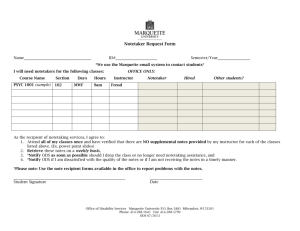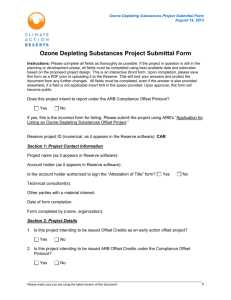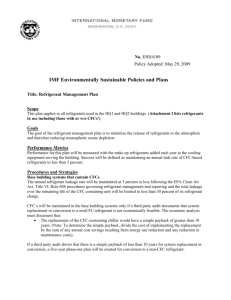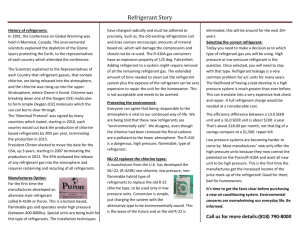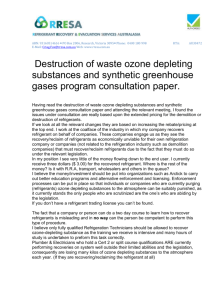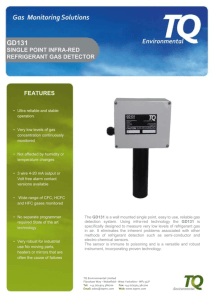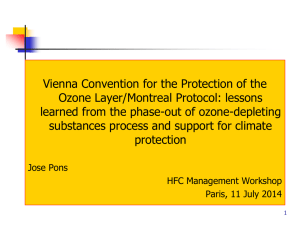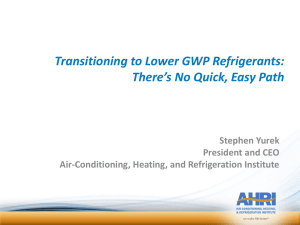Global Warming Potential Of Ozone Depleting Substances
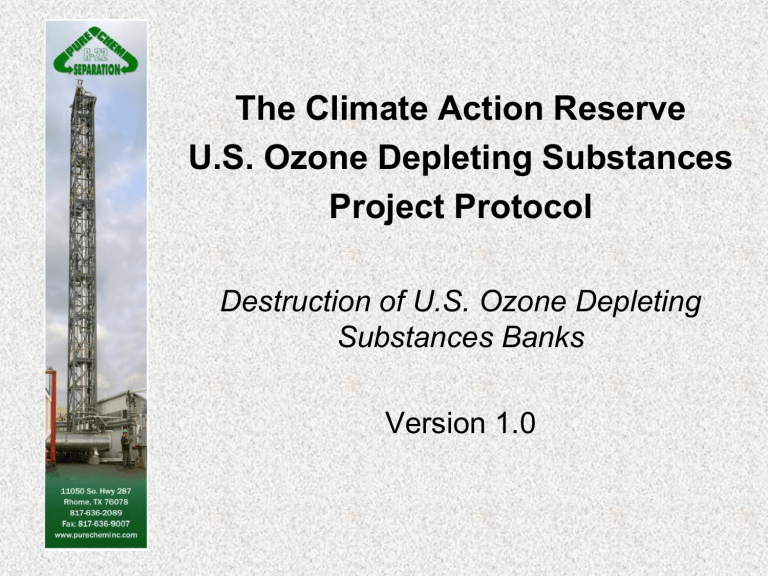
The Climate Action Reserve
U.S. Ozone Depleting Substances
Project Protocol
Destruction of U.S. Ozone Depleting
Substances Banks
Version 1.0
Regulation
of ODS
• The signing of the Montreal Protocol in 1987 lead to amendments to the Clean Air Act in 1990.
• EPA regulations became effective in 1992.
• ODS had multiple uses but use as a refrigerant and a foam blowing agent were by far the largest.
• Regulation of refrigerant included:
1. A ban on release to the atmosphere (venting).
2. Establishment of Certified Reclaimers to recycle the material.
3.
A ban on the production/import of CFC’s effective Jan 1, 1996.
Note there was not ban on the use, just production.
ODS’s also have very high
Global Warming Potential (GWP)
• Original legislation and regulation was because
CFC’s destroyed the ozone layer.
• As global warming became an issue it was observed that CFC’s have a high GWP.
• There are five CFC’s rather widely used as refrigerants and the CAR protocol recognizes four of them, R-11, R-12, R-114, R-115.
Global Warming Potential
Of Ozone Depleting Substances
Refrigerant
R-11
R-12
R-114
R-115
Carbon
Conversion
Factor
1.79
4.35
3.18
2.33
Metric Tons of CO2
Equivalent
1,000 lbs.=1,790
1,000 lbs.=4,350
1,000 lbs.=3,180
1,000 lbs.=2,330
Destruction vs. Continued Use as a
Refrigerant
Carbon offsets are created because refrigerants are destroyed that would otherwise be used as refrigerants and ultimately released to the atmosphere.
Eligibility Rules:
1. Location - Must be sourced domestically and destroyed domestically.
2. Project Start Date- Must be submitted to CAR within 6 months of destruction date.
3. Additionality - GHG reductions must be in addition to what would have otherwise occurred without a GHG market.
A.
Legal requirement test – No law or regulation mandates destruction. Must be voluntary.
B.
Performance Standard Test – Established by CAR that demonstrates common practices would lead to eventual release to the atmosphere.
4. Regulatory Compliance – Project must be in material compliance with all applicable laws and regulations e.g., air, water quality, safety, etc.
Role of the Project Developer
1. Source the ODS material from an eligible source.
Customer base of over 1,000 contractors on buy back program.
2.Process the material to meet specifications for oil and moisture.
High volume reclaim machines for processing refrigerant.
3. Test material to ensure it meets specifications.
Fully equipped laboratory with 6 Gas Chromatographs, Karl
Fischer, Goetz tubes, and acid titrator.
4. If ODS is mixed, circulate in mixing tank.
Mixing Tank Meeting All CAR Protocol Specifications
The process must be conducted and verified by a third party
5. Send Sample to third party authorized laboratory
6. Develop a Monitoring and Operation Plan.
• The M & O plan describes all monitoring, operational, reporting activities and procedures to be followed throughout the project.
• It serves as the basis for the verification bodies to confirm that all requirements of the protocol have been met.
• It describes how data will be collected, stored and provided to the CAR ODS tracking system.
7. Send the refrigerant to an approved incineration facility.
Fleet of Tankers for Transporting Refrigerant to the Incinerator
8. Incineration
A. Refrigerant is sampled again.
B. Chain of Custody is established.
C. Tanker is weighed heavy on certified scales.
D. Refrigerant is incinerated.
E. Tanker is weighed light.
F. Certificate of Destruction is issued.
G. Stack gas monitoring data is issued.
9. Greenhouse gas emission reductions are calculated.
Complex calculations very conservatively calculate the reductions.
A. Baseline emissions based on the refrigerant destroyed.
B. Project emissions are subtracted from the baseline.
10. Verification process begins
The third party verifier has been trained by CAR and is ISO certified.
A review is made to ensure there is no conflict of interest between the parties.
The verifier visits the project developers facility to audit records, procedures and data and verifies calculations.
The verifier visits the incinerator to audit records and stack gas monitoring. (must be 99.99% destroyed)
The verifier issues a report and opinion and submits it to
CAR.
11. Final review by CAR and, upon approval, issuance of Climate Reserve Tonnes (CRT)
• CAR reviews the verifiers report and opinion.
• Upon approval by CAR the CRT’s are issued and available for trading.
• The process takes about 120 to 160 days.
• This is not an easy process. Careful attention to detail is required at every step of the way.
Completed Projects
Pure Chem Separation has completed two domestic ODS projects under the CAR protocol. CRT’s were issued and sold.
• One project was concentrated ODS
• The other project was mixed ODS
• Two additional projects are in process. One has already been incinerated and the other is scheduled for early
July. Both are expected to issue in September.


